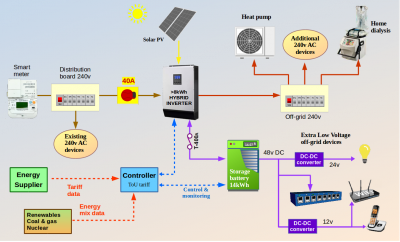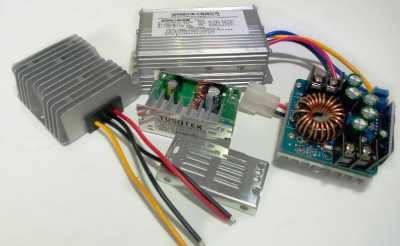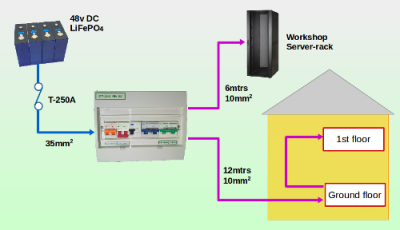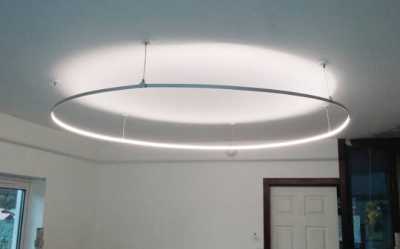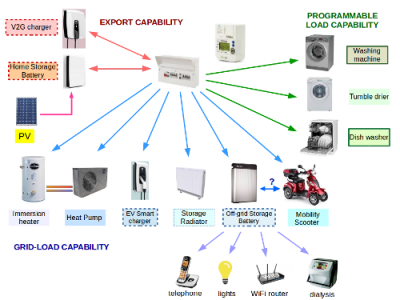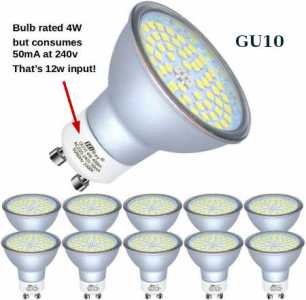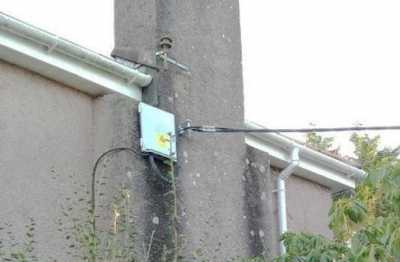Extra Low Voltage devices
Extra Low Voltage (ELV) refers to electricity supplies of 50v and below. These are usually DC, but need not be so.
Why Extra Low Voltage?... because the regional electricity Distribution Network Operators already use the term Low Voltage to refer to 240v (single-phase) and 440v (3-phase) which feeds our homes.
Over on the topic Anyone want to share costs on batteries, we've been discussing the merits of those batteries being grid-tied or off-grid.
In the course of those discussions I have dropped in a number of diagrams similar to this:
In this topic we are concerning ourselves with the bottom-right of that graphic.
These are devices in the home which can be run directly from the battery rather than via the 240v AC output of the off-grid inverter.
Why should we want to do that?
- A householder is permitted to run their own cables and sockets for ELV. Employing a qualified electrician is not mandatory.
- Devices powered directly from the battery will remain live in the event of a power-cut
- It is more efficient to connect devices this way
Each time we pass the stored electricity through a conversion unit to change its voltage/frequency, we lose some of the energy in the process. It makes little sense to take the 48v DC from a Storage Battery, pass it through the Inverter to create 240v AC, and then use a 'transformer plug' to connect a landline phone at 12v DC.
Save energy... recycle electrons!
Interesting topic.
My portable marine fridge fridge freezer runs off only 12v, plugs into a 12v cigarette lighter type socket. I use it for camping.
So begs the question how far could we go in the future in running much more appliances off 12v. Could a lot be run this way?
Do we need standards for appliance manufacturers? What might the limits be in terms of the types of appliances and load?
Lots of questions arise from those points @jeff Since there are few 'Standards' let me start by addressing the issue of which voltage to use.
Twenty years ago I attended a day-long symposium at the University of Bath, where most participants were European manufacturers/researchers in the field of high-brightness 'white' LED light. I have no idea why they thought to invite me, but it was an excellent introduction to a field of engineering which we now take for granted. 😎
One interesting conclusion from the day was a call for all homes to be wired with 24v DC in addition to mains power at 230-240v AC. Over the years I have been doing precisely that, whilst learning what does and doesn't work.
Any move towards DC cabling in the domestic environment must surely start by acknowledging that 100-years use of lead-acid batteries has led us to a field which is dominated by three voltages: 12, 24 & 48v.
Let's suppose we wish to deliver these three possible DC voltages to drive a 'load' of 200w.
To derive the wire-size required to carry the current, I've looked at websites used by railway modellers like this. They have decades of experience with ELV and know how to operate within adequate safety margins. I've assumed we are running a pair of wires next to each other, with a voltage drop no more than 4% at room temperature 20-25°C
The price per 100m cable-drum is from CPC/Farnell, including VAT, and refers to the cheapest red or black wire which meets or exceeds the minimum specification. (For obvious reasons, please don't use brown/blue for ELV circuits!)
It is clearly very much cheaper to wire a house with 48v than with 12v or 24v because copper wire is expensive. However, there are very few devices available which can take 48v input. I have only one - an wired-network hub with Power Over Ethernet (PoE) capability.
Most home devices will require 12v or 24v, just as Jeff's camping fridge does.
Since I'm now starting afresh with a large-capacity 48v LiFePO4 battery, I will be taking 48v to my home 'distribution points' and then stepping down to the required voltages using DC-DC converters.
Save energy... recycle electrons!
Thanks, interesting
May i ask what size wires you have decided to use then, are you going for the 200w capacity?
Have you an idea of what amount/percentage of your energy will be via the low voltage setup annually ?
I am rather confused as to what you are actually trying to achieve.
It would appear that your intention is to take 48v DC, convert it to AC, then back to 12v DC, within a DC to DC Converter. rather than take 48v DC and convert it to 240v AC. Besides to cost of the DC to DC Converters along with additional wiring around your home you will have the power loss within the converter and additional cabling.
Unless you can get equipment rated for 48v DC, I cannot see any real gain, and if you move home in the future you may have to replace lots of DC powered devices that you can no longer use.
Posted by: @jeffMay i ask what size wires you have decided to use then, are you going for the 200w capacity?
I think that would be lacking in adventure 🙂
Here's an overview of the intended 48v wiring to the existing ELV wiring positions.
And here's the DC-DC converter panel for the bottom of the server rack under construction:
This server-rack location requires 19v for PC and monitors. 19v is commonly used for laptops too.
Posted by: @derek-mI am rather confused as to what you are actually trying to achieve.
[...] if you move home in the future you may have to replace lots of DC powered devices
My house already has a high proportion of inbuilt 'devices' which operate at 24v. Here, for example is the light I made for the main living room:
Remember, I started embedding 24v DC into the fabric of the building soon after attending the Bath Uni symposium. Initially these operated from a 1.7kW wind turbine supplying lead-acid batteries.
At 2m diameter, this living room light is very much a fixture. It wouldn't be taken to another house in the event of future move.
Save energy... recycle electrons!
Posted by: @jeffHave you an idea of what amount/percentage of your energy will be via the low voltage setup annually ?
I'm now looking at this from the opposite viewpoint... using ELV unless there is a reason not to do so.
The current objective is to create a system which can run heat-pumps from off-grid battery as much as possible.
If we could do this for 20hrs/day, whilst reverting to mains-grid only for 4hours whilst the batteries are being re-charged, that would be good. Such an approach would reduce the adverse affects of heat-pumps on the Distribution Grid by 83% - which the DNOs would love!
Let me post here I diagram I first put on the OVO Forum over 3 years ago. It shows home devices which could be operated using the Auxiliary Load Control Switch (ALCS) feature inbuilt to our Smart Meters:
Notice how many of these devices require 240v AC to run them - mainly those with motors. But the heat-pump is by far the most significant because it is expected to operate 24/7.
If we can 'crack' the heat-pump issue, then it's really only the EV-charger which you probably wouldn't feed from a home storage-battery.
When customers apply to their DNO to connect Low Carbon Technology (Heat Pumps or EV Chargers) the form requires the Maximum Demand of the house to be calculated. I was pleasantly surprised to learn just how low this figure generally is. My own house (300m²) takes 20A before adding the EV Charge-Point.
Save energy... recycle electrons!
Are your ELV applications generally fixed wiring? There is a fair amount of available 12V automotive plug in equipment, generally using cigarette lighter sockets -phone/laptop chargers, lights. Would you use those, or are you bespoke / some other preferred plug and socket for use at ELV?
20 years ago there would have been significant losses associated with converting 240V-5V dc, and very significant standby loss of 1-5W from the bulky 50Hz transformers. They can be, and generally are now, significantly better - I think 100mW is common, and that is only going down.
I like the resilience an ELV system gives in the event of a power cut, so I can see it being a great idea for lights, internet, maybe a few other low power things.
Having worked on and helped design many highly complex systems over the years, one of the things that I learned fairly quickly was keep it as simple as possible. Adding complexity not only adds to the costs, but also introduces an additional point of failure.
I appreciate that you and a few others may like to experiment (I do so myself), but sometimes the benefits may not be as great as first envisaged.
I welcome and indeed encourage your efforts to help mitigate the effects that both renewable energy production and modern energy appliances are having on the DNO's and the overall operation of the National Grid. I also feel certain that all involved will be more than happy to allow their customers to solve their problems. Don't get me wrong, I have been doing my bit for quite a number of years to become as 'grid neutral' as possible.
You can correct me if I am wrong, but there would appear to be two distinct, but often complimentary, main problems that both the DNO's and National Grid experience to a greater or smaller extent.
The first is matching supply to demand, which often entails transporting energy in bulk over large distances, with the cost of the required infrastructure and inherent losses.
The second is balancing the loading between the 3 phases, so that the infrastructure and losses can be minimised at a more local level.
The former will probably require the storage of electricity in bulk as more and more renewable generation comes on line, or the production of green hydrogen for use in gas fired power stations. Work is being carried out at the moment on the development of Iron-Air batteries for the bulk storage of electrical energy, which it is claimed will be a much cheaper alternative to Lithium batteries. Domestic storage systems may help to some extent, but will no doubt not always be located in the correct place and will not always be available for use.
I have been giving some thought to the second of the two main problems, balancing the loading phase to phase. I know that National Grid are not allowed to generate electrical power, but I'm not certain if the same restriction applies to DNO's. Also, does storing energy in batteries and then producing AC using an inverter count as generation? My idea to help balance the phases would be to have single phase inverters on each of the 3 phases at suitable locations within the local DNO network. Each inverter would be connected to a common battery storage system of adequate size. On the phase with the highest demand, energy would be drawn from the battery storage to help mitigate the loading, whilst energy from the lowest loaded phase could be drawn to charge the batteries via the inverter. This method may also help to alleviate the supply to demand problem.
I feel that the above would be much more cost effective than having individual domestic storage systems, and also would be much more beneficial to the DNO's, since it would be under their control. I also feel that much of the initial cost could be recouped from infrastructure and efficiency savings, and will eventually lead to savings for customers along with a more reliable and resilient electricity network.
Posted by: @derek-mHaving worked on and helped design many highly complex systems over the years, one of the things that I learned fairly quickly was keep it as simple as possible.
In many cases I would agree. But I could easily apply that argument to the ubiquitous GU10 LED light bulb.
It's the most common type used in kitchens, which in turn is the room in the house which has a requirement for the highest level of illumination. As such the DIY warehouses sell far more of these than other LED bulbs. They would say "there is high customer demand".
Invariably the GU10 have the shortest lifetime of all LED types because the embedded electronics runs hot. This can't readily be dissipated within the confines of a bulb being fed from 240v AC.
So why should anyone consider changing away from such a simple product? After all, it's LED, so it must be efficient, mustn't it?
It's now 11 years since the UK ceased manufacture of incandescent bulbs. But the GU10 halogen bulb could hang on until September last year (2021) and still be sold 'whilst stocks last'.
The GU10 is expensive in the long term because you get through so many of them, whether they're LED or not. There have been better alternatives for the past decade, and I'm disappointed to see new houses being built close to me for a Housing Association which still have GU10 fittings in the kitchen ceilings.
Yes, it's more complicated to separate the LED light source from the electronics which supplies it. But I have no doubt that is the better solution.
Save energy... recycle electrons!
Posted by: @derek-mI know that National Grid are not allowed to generate electrical power, but I'm not certain if the same restriction applies to DNO's. Also, does storing energy in batteries and then producing AC using an inverter count as generation? My idea to help balance the phases would be to have single phase inverters on each of the 3 phases at suitable locations within the local DNO network.
I discussed this very solution with my DNO in the initial year of the OpenLV Project to have monitored substations. Great minds etc.... 😎
DNOs too are not permitted to own generation assets. And Storage falls within that definition.
There is no such restriction on members of the wider community offering 'balancing services' to their DNO. This already forms part of the revenue streams handled by both DNOs and National Grid.
Since Western Power Distribution have generously provided a 3-phase connection to my house, you can see which way I'll be heading. 🙂
There are seven main categories of 'losses' which exist on the Grid. I've illustrated them in detail on the OVO Forum topic Balancing the Grid. Phase-imbalance is just one subsection within the 7th definition I've listed.
If you'd like to discuss these in more detail can I suggest
- we create a new topic about Grid Losses and the RIIO-ED2 Agreement for DNOs to take action to reduce these
- you copy the graphics from that OVO Forum article into that new topic as required. Either I own the copyright or else I have permission from Western Power to reproduce their material for purposes of education and public awareness.
Save energy... recycle electrons!
- 26 Forums
- 2,367 Topics
- 53.7 K Posts
- 218 Online
- 6,042 Members
Join Us!
Worth Watching
Latest Posts
-
RE: Help needed with Grant Aerona 3 issues
Noted. Its a pity you didnt capture the flow rate and ...
By JamesPa , 4 hours ago
-

RE: Best Heat Pump Brand in the UK
Last Call to Vote & Win! Haven't voted for your Hea...
By Mars , 4 hours ago
-

RE: Solis S6-EH1P8K-L-PLUS – Why I Chose It and What I’ve Learned So Far
Interesting question. To be frank, since I have no inte...
By Majordennisbloodnok , 11 hours ago
-
RE: Changing from 4-port buffer to volumizer
@andy1618 see the very sage advice from @editor above. ...
By JamesPa , 20 hours ago
-
RE: New Fogstar 15.5kWh upright solution
The video shows the JK balancer, but the connection of ...
By Batpred , 23 hours ago
-
RE: Ecodan unable to hit legionella target temp - what's the consensus?
@9jwr9 Hi, yes this is the issue with every (stand alon...
By ASHP-BOBBA , 24 hours ago
-
RE: Help me keep the faith with my air source heat pump installation
@adamk FWIW I managed unintentionally to 'coax' mine in...
By JamesPa , 1 day ago
-
RE: Octopus Cosy Heat Pump Owners & Discussion Thread
You are in essence right. Adia only works with selecte...
By JamesPa , 1 day ago
-

No, you haven’t missed out, @batpred. This thread’ll st...
By Majordennisbloodnok , 1 day ago
-

RE: Tesla Powerwall – More of a ‘Luxury’ Than an ROI Winner!
Also, though they weren’t prepared to match the price t...
By Toodles , 1 day ago
-
RE: How long will your energy contract last?
My INTELLI-FIX-12M-25-08-29 has less than 12 months to ...
By Batpred , 1 day ago
-

RE: GivEnergy 2025 forthcoming batteries and inverters
Then, perhaps @toodles , you should've made a submissio...
By Transparent , 1 day ago
-
RE: Balancing financial efficiency and comfort using the Octopus Cosy tariff
I am wondering if anyone with an EV could find the 7p/k...
By Batpred , 1 day ago
-
Possibly, but it would also reduce DeltaT across the em...
By JamesPa , 1 day ago
-

RE: ASHP sizing - value of Heat Transfer Coefficient
@cathoderay It was reminiscent of the BBC Open Universi...
By Toodles , 1 day ago
-
-

@morgan They are unsupervised these days, can’t get the...
By Toodles , 4 days ago
-

RE: Setback savings - fact or fiction?
Exactly. We only need to compare conditions, to decide ...
By cathodeRay , 5 days ago
-
RE: Need Help Optimising My Rushed ECO4 Install: 12kW Bosch Heat Pump
Welcome @mickamills We too have an oversized 12kW Sa...
By Old_Scientist , 6 days ago

